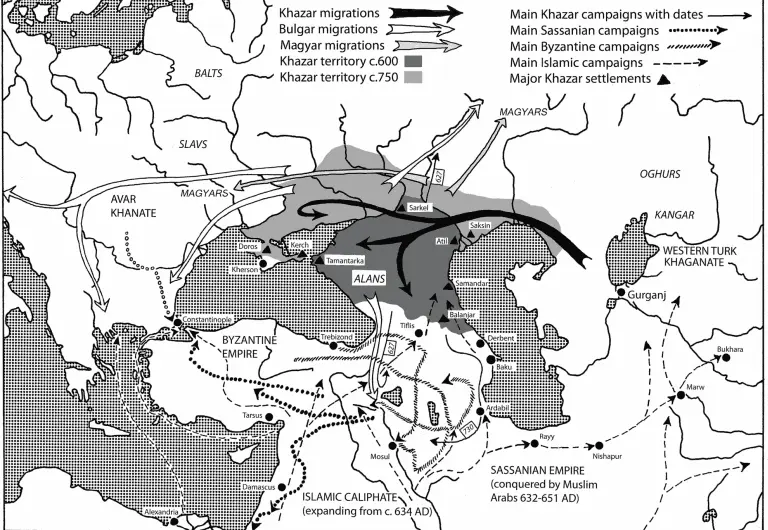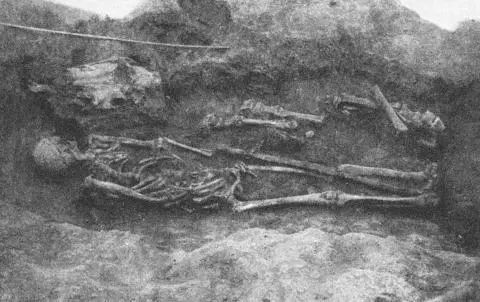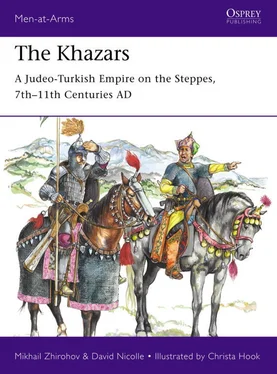Mikhail Zhirohov and David Nicolle
THE KHAZARS
A JUDEO-TURKISH EMPIRE ON THE STEPPES, 7th–11th CENTURIES AD
Illustrated by Christa Hook
THE KHAZARS 7th–11th CENTURIES
HISTORICAL BACKGROUND
The history of the Khazar Khaganate, which for many years dominated the steppes of South-Eastern Europe as well as much of the steppe territory of Western Asia, is important for a proper understanding of the history of early medieval Eastern Europe. Both extensive and enduring, this power straddled several important trade routes, serving as a channel for ideas, technologies and artistic influences mostly (though not only) from East and South to North and West. Furthermore, the Khazars played a major role in the struggle between the competing Christian and Islamic empires.
An independent Khazar state emerged in the 7th century, primarily based upon the lower courses of the mighty Volga and Don rivers. The Khazar Khaganate then expanded to incorporate under its rule or influence an array of differing peoples, from the originally nomadic Turkic Khazars themselves, to partially nomadic Alans who spoke an Iranian language; Bulgars (Bulghars), who were then still Turkic rather than Slavic; Burtas, whose linguistic identity remains a matter of dispute; Finno-Ugrian Mari of the mountains, forest and river plains; semi-nomadic Magyars, who were ancestors of today’s Hungarians; and nomadic Turkic Pechenegs, who would eventually inherit the western steppes as the Khazars faded from history. A number of Eastern Slav tribal associations were similarly dominated by the sprawling Khazar Khaganate. All these peoples paid tribute to the Khazar rulers, and were, at various times and to varying degrees, under Khazar domination◦– although in many cases this relationship was based upon mutually beneficial trade rather than military force. The Khazarian state (i.e. the multi-ethnic polity dominated by the Khazars) existed for about 300 years before it collapsed in the mid-10th century◦– a long time for a steppe empire based upon largely or partly nomadic tribes. Furthermore, the Khazars left a significant mark on the history of a large part of Eastern Europe and beyond.

Khazar engraved bone object from Maiaky, Ukraine, depicting men in combat. Despite the naive technique the armoured lancer (bottom left) is shown in some detail: helmet, mail coif and hauberk, and, on the far side, what may be the end of a cased bow, are all discernible. The other rider’s armour is differentiated, perhaps to suggest a lamellar cuirass; the shaded discs may represent discarded shields. (Archive of M Zhirohov)

Map showing the rise of the Khazars in the 7th–8th centuries AD. (David Nicolle)
Origins
According to the Byzantine emperor and chronicler Constantine VII Porphyrogenitus (ruled [r.] AD 913–959), the original Khazars were Turks. However, some other writers believe they had similar Finno-Ugrian origins to the Magyars or Hungarians, and still others maintain that they had comparable origins to the Georgians of the Caucasus. Such uncertainties are common with regard to early-medieval steppe peoples, but in the case of the Khazars the issue has latterly become entangled with unpleasantly racist rather than simply scholarly concerns. In the 8th century the Khazars, or at least their ruling elite, converted to Judaism; consequently, their history has aroused a sometimes anti-semitic interest in the pretended ‘Jewish ethnicity’ of communities of Eastern European, Caucasus and Central Asian origins, or in the Turkic rather than semitic origins of Eastern European Jewish communities.
The first reliable written source concerning the Khazars might date from as early as the 2nd century AD, when tribes later sometimes identified as Khazars occupied land north of the Caucasus, clashing with Armenians and enjoying notable success until the 4th century. Whether or not they really were ethnically related to the later Khazars is nevertheless questionable. During the astonishing expansion of the vast but ephemeral Hun Empire in the late 4th and early 5th centuries, these possible proto-Khazars disappear from history, but when they suddenly re-emerge in the 6th century they already control a large territory. In the east, their lands bordered nomadic tribes known simply as Turks; in the north their neighbours were Finnish tribes; in the west, they were Turkic Bulgars; while in the south, Khazar territory bordered that of the Alans and reached the River Araxes (Aras). Once they had freed themselves from the Huns, the Khazars consolidated their own power and began to threaten neighbouring peoples. Indeed, the Khazars became so troublesome that the Sassanian Persian ruler or Shahinshah Kavadh I (r. AD 488–496 and 498–531) and his son Khusrow I (531–579) had long fortifications built from the mountains to the sea in northern Shirvan. Repaired and rebuilt many times, parts of these impressive Walls of Derbent are visible to this day.
During the 7th century the Khazars took advantage of divisions among their long-standing Bulgar rivals to seize control of territory north of the Black Sea. Thereafter the loose association of Bulgar tribes split apart, some migrating north to establish a new state around the confluence of the Volga and Kama rivers (see MAA 491, Armies of the Volga Bulgars & Khanate of Kazan). Some migrated into the Balkans to establish a state which still exists as Bulgaria, and others fled even further afield, but some remained in place under Khazar rule.
It was also during the early 7th century that the Byzantine Empire started paying serious attention to this rising new power. Clearly the Khazar tribes could have endangered the Byzantines, so the latter offered gifts and, in time-honoured fashion, formed links by marriage with the Khazar ruling family. It was by such means that the Emperor Heraclius (r. 610–641) was able to win the Khazars to his side in Byzantium’s final war with the Sassanian Empire.
This proved to be a fleeting victory, followed almost immediately by the sudden and unexpected eruption of the newly Muslim Arabs from the Arabian Peninsula. Byzantine armies were tumbled back to what would become the Empire’s heartland of Anatolia, while the weakened Sassanian Empire collapsed entirely. A newly emergent superpower, the Islamic Caliphate, soon challenged the Khazars themselves. Now a genuine Byzantine-Khazar alliance developed (though subsequently some Byzantines would advocate a different alliance with Alans and Ghuzz against the Khazars).
Attempts by the Khazars to oppose Arab-Islamic expansion were initially unsuccessful, although their forces achieved some victories. When their capital at Balanjar just north of the Caucasus was sacked, the Khazars moved their centre a short distance north to Samandar on the Caspian coast. After this too was destroyed the Khazar capital was moved again, this time to Atil (or Itil) in the delta of the Volga River. Only a defeat of the Muslims on the banks of the Bolangira saved Khazaria from collapse, and thereafter Atil remained the administrative centre of the Khaganate until the Khazar state was eclipsed in the 960s AD.

A typical grave of a Khazar warrior and his horse from the northern Caucasus. Note the considerable length of the sabre lying across his left leg. (Archive of M Zhirohov)
Читать дальше
















